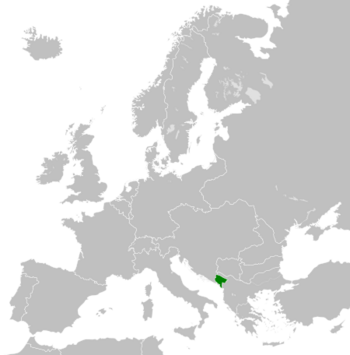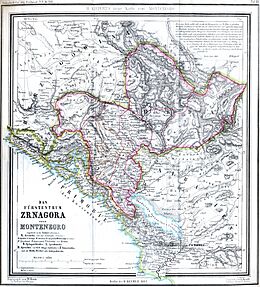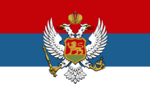Principality of Montenegro facts for kids
Quick facts for kids
Principality of Montenegro
Књажевина Црна Горa
Knjaževina Crna Gora |
|||||||||
|---|---|---|---|---|---|---|---|---|---|
| 1852–1910 | |||||||||
|
|
|||||||||
|
Anthem: Убавој нам Црној Гори
Ubavoj nam Crnoj Gori (English: "To Our Beautiful Montenegro") |
|||||||||

The Principality of Montenegro in 1890.
|
|||||||||
| Capital | Cetinje | ||||||||
| Common languages | Serbian | ||||||||
| Religion | Majority: Serbian Orthodox Church Minority: Islam |
||||||||
| Demonym(s) | Montenegrin | ||||||||
| Government | Unitary absolute monarchy (de facto) Unitary semi-constitutional monarchy (1852–1905) Unitary constitutional monarchy (1905–1910) |
||||||||
| Prince | |||||||||
|
• 1852–1860 (first)
|
Danilo I | ||||||||
|
• 1860–1910 (last)
|
Nikola I | ||||||||
| President of the Ministerial Council | |||||||||
|
• 1905–1906 (first)
|
Lazar Mijušković | ||||||||
|
• 1907–1910 (last)
|
Lazar Tomanović | ||||||||
| Legislature | None (rule by decree) (until 1905) Popular Assembly (from 1905) |
||||||||
| History | |||||||||
| 13 March 1852 | |||||||||
|
• Battle of Grahovac
|
1 May 1858 | ||||||||
|
• Battle of Vučji Do
|
18 July 1876 | ||||||||
| 13 July 1878 | |||||||||
|
• Constitution adopted
|
19 December 1905 | ||||||||
| 28 August 1910 | |||||||||
| Currency | Austro-Hungarian Krone (1892–1906) Montenegrin Perper (1906–1910) |
||||||||
|
|||||||||
| Today part of | Montenegro | ||||||||
The Principality of Montenegro was a country in Southeastern Europe. It existed from March 13, 1852, to August 28, 1910. After this, it became the Kingdom of Montenegro. Nikola I was the ruler who made this change. He then became the first King of Montenegro.
The capital city was Cetinje. From 1906, the country used the Montenegrin perper as its money. The land it covered is now the central part of modern-day Montenegro. It was officially a constitutional monarchy, which means the ruler's power was limited by a set of laws.
Contents
Understanding the Name of Montenegro
The name of Montenegro changed over time. In 1855, Prince Danilo I called himself the "prince and lord of Montenegro and Brda." Brda was another region nearby.
Later, in 1870, Nikola used the title "prince of Montenegro and Brda." Just two years later, the country was officially called the "Principality of Montenegro."
History of the Principality
Prince Danilo's Rule
The Principality began on March 13, 1852. This happened when Danilo I Petrović-Njegoš decided to stop being a prince-bishop. He gave up his religious role and got married. This made Montenegro a secular country, meaning it was no longer ruled by religious leaders.
In 1855, Montenegro got its first constitution. It was called "Danilo's Code."
Danilo's older brother, Grand Voivode Mirko Petrović, led a strong army. On May 13, 1858, his 7,500 soldiers won a very important battle. They defeated a much larger Turkish army at Grahovac. This big victory made other powerful countries notice Montenegro. They officially drew the borders between Montenegro and the Ottoman Empire. This meant they recognized Montenegro's independence, which it had fought for centuries. Montenegro gained new lands like Grahovo and parts of other regions.
Prince Nikola's Rule
After Danilo I was assassinated on August 13, 1860, his nephew Nikola I became the new ruler. Nikola helped Serb rebels in a revolt in Herzegovina. Then, he led Montenegro into a war against the Ottomans from 1876 to 1878.
Russian forces advancing towards Turkey led to a peace treaty on March 3, 1878. This treaty recognized Montenegro's independence. It also greatly increased Montenegro's size. The country grew from about 4,405 square kilometers to 9,475 square kilometers. Montenegro also gained important towns like Nikšić, Podgorica, and Bar. This gave Montenegro access to the sea.
The Treaty of Berlin later confirmed Montenegro's independence. Under Nikola I, Montenegro and the Ottoman Empire had peaceful relations for about 30 years. This was unusual, as they had often been at war.
Nikola I worked to modernize the country. This led to a new Constitution in 1905. However, some people wanted more democracy and a union with Serbia. Others wanted to keep the prince's power strong.
How Montenegro Was Governed
The Rulers
- Danilo I (March 13, 1852 – August 13, 1860)
- Nikola I (August 13, 1860 – August 28, 1910)
National Flags
The old war flags of Montenegro were called krstaš-barjak. These were simple flags with crosses in the middle. For example, the flag used in the Battle of Vučji Do in 1876 was red with a white cross and a white border. This design came from a Serbian war flag.
According to the 1905 constitution, the national flag became a tricolour. It had three colors: red, blue, and white. This was the Pan-Slavic Serbian tricolour.
The 1855 Constitution
Danilo I created his "General Law of the Land" in 1855. It was also known as "Danilo I's Code." This code was based on Montenegro's old traditions and customs. It is seen as the first national constitution in Montenegrin history.
The code set rules, protected people's privacy, and stopped fighting on the Austrian Coast. It also said that even though most people were Serb and Orthodox Christian, "each foreigner and each person of different faith can live here and enjoy the same freedom."
The 1905 Constitution

By the early 1900s, Montenegro had grown in size and enjoyed peace for nearly 40 years. Prince Nikola I had ruled for a long time. Many saw him as a skilled leader.
However, some younger people, who had studied abroad, wanted changes. They thought his rule was too strict. They wanted a parliament and a constitution. This opposition grew, supported by some military leaders and clan representatives.
For years, Prince Nikola argued that Montenegro was not ready for a constitutional monarchy. He feared that a parliament would cause old clan rivalries to restart. But after the revolution of 1905 in Russia, Montenegro was one of the last countries in Europe without a constitution.
Finally, under public pressure, Prince Nikola decided to grant a constitution. He announced this on October 31, 1905. He said he was giving it freely and that changes would be gradual. He asked a journalist from Serbia to write it. The new constitution was similar to Serbia's 1869 constitution, with small changes for Montenegro.
The Constitution of the Principality of Montenegro was put in place by Nikola I on December 19, 1905. The parliament formally accepted it but did not discuss it. It became known as the St Nicholas day constitution. It had 15 chapters and 222 articles. It set up the government, defined state symbols, and outlined human rights.
Montenegro became a constitutional monarchy. This meant the parliament shared law-making power with the prince. The prince was the head of the army and handled foreign affairs. He could declare war and sign peace treaties. He also appointed government officials.
Every adult male citizen could be elected to parliament, as long as they had not been convicted of a crime. Soldiers could not vote. To be a member of parliament, a person had to be over 30, live in Montenegro, and pay a certain amount of taxes. Elections were direct. Members of parliament served for four years.
Besides elected members, 14 seats in parliament were for important officials. These included the Metropolitan of Montenegro (a religious leader), the Archbishop of Bar, the Montenegrin Mufti, and other high-ranking officials.
No law could be passed or changed without parliament's approval. However, only the government could formally propose new laws. Parliament could approve the budget, but it could not use this to force the government to change. If parliament rejected the budget, the prince could just use the previous year's budget. This showed that the constitution did not fully limit the ruler's power. Still, no new tax could be added without parliament's agreement.
The prince appointed and dismissed ministers. The Council of Ministers managed the country's daily business and reported directly to the prince. Ministers could be held responsible for their actions by parliament or the prince. They could be charged for serious offenses like treason or corruption.
A State Council, with six members chosen by the prince, acted as a high court for administrative matters. There were also high courts and local municipal courts. Judges were independent. The constitution also created local self-governance through municipal courts and assemblies.
It guaranteed civil rights and freedoms, like equality before the law. It ended the death penalty for purely political reasons, except for attempts on the prince's life. The right to personal property, freedom of the press, and the right to assembly were also protected.
Despite its limitations, the 1905 Montenegrin Constitution was an important step. It brought modern ideas of human rights and freedoms to this small Balkan country.
Population History
- In 1882, one estimate said the Principality had 160,000 people. A more common estimate was around 230,000.
- By 1900, international sources reported 311,564 inhabitants. Most (94%) were Eastern Orthodox. About 4% were Muslims, and 3% were Roman Catholic. About 23% of the people could read and write.
- In 1907, the population was estimated to be around 282,000, mostly Orthodox Christians.
- In 1909, the first official census was taken. It counted 317,856 people. However, the real number was closer to 220,000. The official language, Serbian, was spoken by 95% of people. Most of the rest spoke Albanian. By religion, 94% were Orthodox Christians, with most of the rest being Muslims and a small number of Roman Catholics.
Regions of Montenegro
The Principality of Montenegro was divided into 10 administrative areas. These were called nahija (plural nahije).
- Katunska nahija
- Riječka nahija
- Crmnička nahija
- Primorska nahija
- Lješanska nahija
- Zetska nahija
- Brdska nahija
- Vasojevićka nahija
- Moračka nahija
- Nikšićka nahija
The Church
The Metropolitanate of Cetinje was separated from the state by Danilo I. It was part of the Serbian Orthodox tradition. While it was officially under the Ecumenical Patriarchate of Constantinople, it acted mostly on its own.
In 1908, another church region, the Eparchy of Zahumlje-Raška, was created. The Metropolitans of Cetinje during this period included Ilarion Roganović (1876–1882), Visarion Ljubiša (1882–1884), and Mitrofan Ban (1884–1918).








